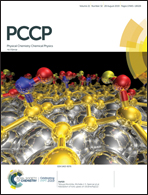Spontaneous proton transfer in a series of amphoteric molecules under hydrostatic pressure†
Abstract
Herein, high-pressure behaviour of a series of amphoteric molecules in the crystal form was investigated, and the detailed experimental and calculated data revealed that hydrostatic pressure could result in intermolecular proton transfer in addition to the previously reported changes in molecular conformations and enhancement of intermolecular forces. Furthermore, by comparing (2-(3,3-dimethyl-3H-indol-2-yl)vinyl)-4-nitrophenol (AM-N) with the control molecules de-nitrated AM, nitro-mismatched OM-N and methylated AM-N-C, it was found that the pressure-triggered proton transfer in the crystal was not a simple loss or gain of protons as that in solution; instead, it involved the sharing of protons by their gradual deviation from a proton donor to a proton acceptor. The proton deviation degree strongly depends on the distance between the proton donor and acceptor in the crystal, rather than molecular acidity and basicity in solution. Moreover, regarding its potential applications, the acid–base conjugated amphoteric molecule AM-N could be applied in accurate colorimetric pressure sensing, and its accuracy was close to that of the widely used high-pressure indicator ruby pressure marker.



 Please wait while we load your content...
Please wait while we load your content...